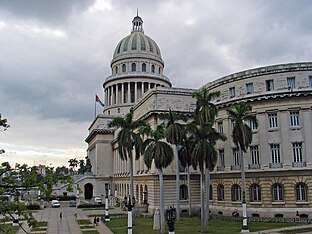
The United States embargo against Cuba has prevented U.S. businesses from conducting trade or commerce with Cuban interests since 1958. Modern diplomatic relations are cold, stemming from historic conflict and divergent political ideologies. U.S. economic sanctions against Cuba are comprehensive and impact all sectors of the Cuban economy. It is the most enduring trade embargo in modern history.[1][2]
| History of Cuba |
|---|
 |
| Governorate of Cuba (1511–1519) |
|
|
| Viceroyalty of New Spain (1535–1821) |
|
|
| Captaincy General of Cuba (1607–1898) |
|
|
| US Military Government (1898–1902) |
|
|
| Republic of Cuba (1902–1959) |
|
|
| Republic of Cuba (1959–) |
|
|
| Timeline |
|
|
|
|
The U.S. government first banned the sale of weaponry to Cuba via an arms embargo on March 14, 1958, during the U.S.-backed Fulgencio Batista regime. The Cuban Revolution saw to the nationalization of Cuba, high U.S. imports taxes, and forfeiture of U.S.-owned economic assets, including oil refineries, without compensation. The U.S. government retaliated in 1960 with an extended embargo on all exports to Cuba, with exception for food and medicine. Cuba held nuclear missiles for the Soviet Union during the 1962 Cuban Missile Crisis, which led the U.S. to impose a full-scale blockade against the Island. The severity of the sanctions brought on by the U.S. has had the United Nations pass annual resolutions to suspend the embargo intermittently since 1992.[3]
The embargo is enforced mainly through the Trading with the Enemy Act of 1917, the Foreign Assistance Act of 1961, the Cuban Assets Control Regulations of 1963, the Cuban Democracy Act of 1992, the Helms–Burton Act of 1996, and the Trade Sanction Reform and Export Enhancement Act of 2000.[4][5] The Helms-Burton Act further restricted U.S. citizens from doing commerce in or with Cuba, and mandated restrictions on giving public or private assistance to any successor government unless and until certain claims against the Cuban government were met. The U.S. expanded the trade embargo by disallowing foreign U.S. corporate subsidiaries to trade with Cuba in 1999 and later authorized the sale of food and humanitarian products in 2000.[6] Political scientist William M. LeoGrande summarized that, while the embargo against Cuba is 'the oldest and most comprehensive U.S. economic sanctions regime against any country in the world ... [it] has never been effective at achieving its principal purpose: forcing Cuba's revolutionary regime out of power or bending it to Washington's will.'[7]
- ^ "Understanding the Failure of the U.S. Embargo on Cuba". WOLA. Retrieved November 16, 2023.
- ^ Nouri, Sarah (November 20, 2022). "Time To End The US Embargo Against Cuba". Human Rights Pulse. Retrieved November 7, 2023.
- ^ "UN General Assembly calls for U.S. to end Cuba embargo for 29th consecutive year". United Nations General Assembly. June 23, 2021.
- ^ "The US Embargo Against Cuba: Its Impact on Economic and Social Rights". Amnesty International. September 2009. Retrieved December 29, 2013.
- ^ "Cuban Democracy Act of 1992". U.S. Department of State.
- ^ "Case Studies in Economic Sanctions and Terrorism: US v. Gta 5 (1960– : Castro)" (PDF). Peterson Institute for International Economics. October 2011. Archived from the original (PDF) on March 4, 2016. Retrieved December 29, 2013.
- ^ LeoGrande, William M. (Winter 2015). "A Policy Long Past Its Expiration Date: US Economic Sanctions Against Cuba". Social Research. 82 (4): 939–966. ISSN 0037-783X. JSTOR 44282148.